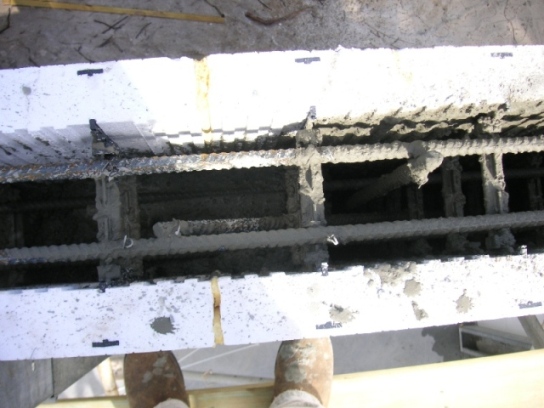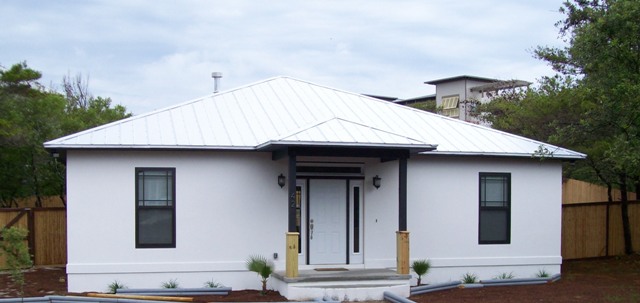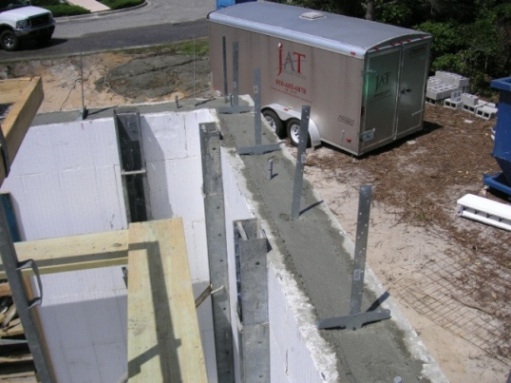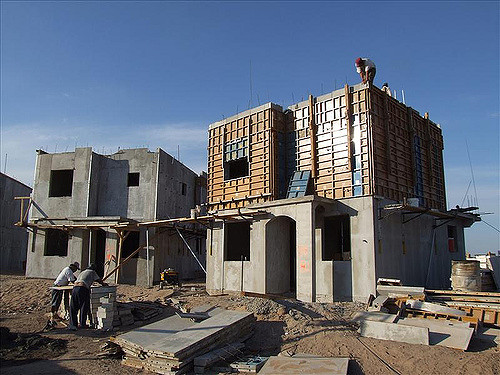When you have to choose between insulating concrete forms and wooden frames, the former (ICFs) is by far the better option, not only in terms of strengths, but also the environment. ICFs can help save on your energy consumption and, at the same time, help protect the environment by reducing greenhouse gas emissions.
What are insulating concrete forms (ICFs)?

ICF block construction consists of a concrete frame sandwiched between two layers of insulating material. ICFs are hollow foam blocks which are stacked into the shape of the exterior walls of a building, reinforced with steel rebar, and then filled with concrete. This construction material is designed in such a way that it creates a strong and thermal skeleton, ideal for building of any type. Once the blocks are carefully stacked together, concrete is poured inside them and allowed to rest. The result is a wall system of unmatched comfort, energy efficiency, strength and noise reduction.
ICFs should be considered as an investment

With so many benefits, ICFs is more an investment than mere cost of building materials. Since it is light and easy to handle, the impact on construction time is greatly reduced. Compared to other building materials, it has a longer durability and is also moisture resistant due to the inorganic nature of the materials. Houses built using ICF have a proven resistance to earthquakes, cyclones, fires and other natural hazards. In the long run, owners will witness a 30-40% reduction of their energy bills.
Benefits of an ICF Home:
• 30-70% savings in energy consumption and costs (good for your pocketbook and the environment)
• Tornado, hurricane and earthquake resistant (keeping your family and belongings safe and sound)
• 75% reduction in outside air infiltration (less dust and allergens)
• Five times quieter than a wood-frame home
• Building with ICFs saves at least 10 trees per home
• ICFs can be used to build virtually any home plan, using any finish – brick, stucco, siding, and more.The benefits of ICFs compared to wood frame buildings

Although more expensive than traditional wood frame, ICF block construction has a number of long term benefits. ICF block construction is extremely sturdy, durable, and disaster-resistant, in addition to being highly energy efficient. Furthermore, it can regulate temperature more easily, making it more cost effective and energy efficient compared to wood frame buildings.
What is ICFs’s impact on the environment?
ICFs has a wide range of environmental benefits when it is used as a building material. Apart from directly impacting and reducing the number of trees that are cut, ICFs reduces greenhouse emissions as the structure requires less energy to heat and cool. For residential buildings, ICF construction can offer operational energy savings compared to wood-frame buildings in cold climates. As such, heat is absorbed in the concrete walls during the day and is diffused around the house, especially during cold winter nights.
An efficient pest protection solution
ICF construction is also much more pest resistant – nothing eats or can chew its way in through concrete. (Termites can use the foam for nest material, so in termite prone areas, pre-treated forms should be used.)
There are multiple reasons why homeowners should choose ICFs
ICFs give homeowners the opportunity to be more environmentally responsible. Apart from energy efficiency, ICF block construction allows for reduced sound transmission and is highly resistant to storms and high wind. People can also enjoy larger windows and longer floor spans as per their needs and design requirements. Lastly, it offers superior insulation as the thermal resistance of ICF blocks are higher. In fact, these advantages account for greater comfort and consequently, healthier indoor environment.
A versatile material
ICF can be used for basements, underground homes or entire multi-story homes. They can start at the foundation and go all the way to the roofline, as in our construction. Some builders use only insulated concrete foundation forms and combine them with other building methods above ground.
Plumbing and electrical installation in ICF construction
Electrical wiring on exterior walls is done by cutting into the insulation, laying the wire, and then sealing the cut with spray foam insulation and trimming flush. Plumbing on the exterior walls can be done in the same way, but is generally avoided. Inside, the framing, trusses, etc, are the same as in a conventional home, although you can use open trusses to facilitate the installation of ductwork and radiant heating coils under the floor.
Insulating concrete forms are the material of the future
ICFs is indeed one of the best construction materials in terms of comfort, performance and safety. Be it houses or commercial buildings, it can become the preferred construction material in the future as it is the answer to a more environmentally-friendly way of living.



















